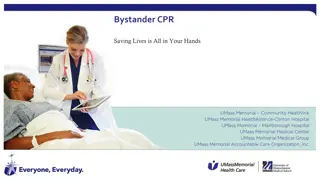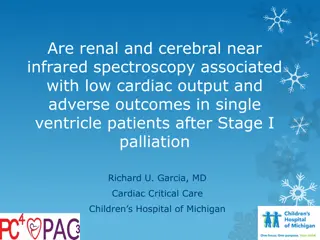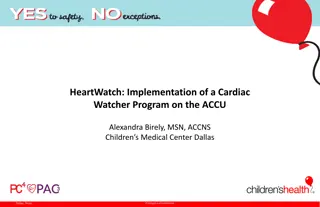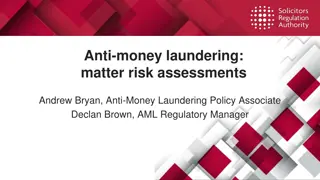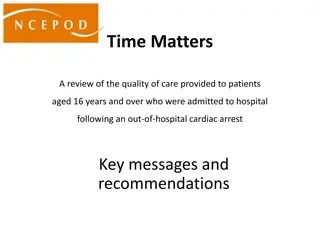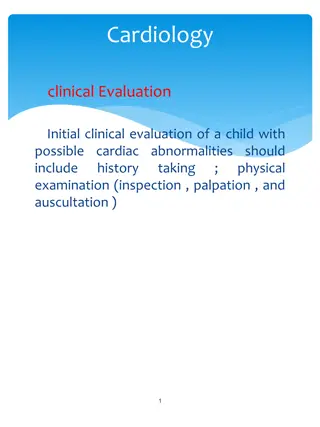Understanding Cardiac Rehabilitation and Physiotherapy Approaches
Explore the comprehensive agenda covering topics like the general structure of the circulatory system, blood circulation in the human body, risk factors for cardiovascular diseases, and physiotherapeutic approaches in cardiac rehabilitation. Gain insights into the anatomy of the heart, arteries, vei
6 views • 14 slides
Bystander CPR: Steps to Save Lives & Facts About Cardiac Arrest
Learn the importance of bystander CPR in saving lives during sudden cardiac arrest incidents. Understand the steps to perform hands-only CPR, identify compression rates, and the role of the Good Samaritan law. Discover key facts about sudden cardiac arrest and how bystander intervention can signific
1 views • 13 slides
Acoramidis Improves Cardiac Function in Transthyretin Amyloid Cardiomyopathy
Acoramidis, a next-generation TTR stabilizer, shows promising results in improving cardiac function and promoting regression in Transthyretin Amyloid Cardiomyopathy. The ATTRibute-CM Cardiac Magnetic Resonance Substudy evaluated changes in cardiac structure, function, and amyloid burden after treatm
0 views • 8 slides
Delving into Implant Monitoring Services for Improved Patient Care
Cardiac implantable devices like pacemakers, cardiac loop records, and implantable cardioverter defibrillators require extensive cardiac implant monitoring services to help safeguard the patients' heart health at all times. Let\u2019s get started.\n
4 views • 5 slides
Understanding Cardiac Output and Venous Return in Cardiovascular Physiology
Cardiac output, stroke volume, end-diastolic and end-systolic volumes play vital roles in cardiovascular function. Factors affecting cardiac output include physiological conditions and pathological states like hyperthyroidism and myocardial infarction. Venous return, controlled by mechanisms like Fr
0 views • 27 slides
Association of Renal and Cerebral Near-Infrared Spectroscopy with Adverse Outcomes in Single Ventricle Patients after Stage I Palliation
Study investigates the association between renal and cerebral near-infrared spectroscopy (NIRS) values and low cardiac output syndrome in single ventricle patients post Stage I palliation. Data from infants who underwent surgery between 2010-2019 is analyzed to determine correlations with adverse ou
0 views • 13 slides
Understanding Cardiac Electrical Activity in Physiology Team's Cardiovascular Block Lecture
Dive into the intricate details of cardiac electrical activity in this lecture led by Physiology Team 436. Explore topics like the cardiac conductive system, action potentials, refractory periods, excitation-contraction coupling, and the effects of autonomic stimulation on heart electrophysiology. D
0 views • 29 slides
Understanding the Cardiac Cycle: Phases and Events Explained
Explore the intricate workings of the cardiac cycle, from the mechanical and electrical changes to the phases in both atria and ventricles. Learn about the time duration of a cardiac cycle, the impact of heart rate on systole and diastole, and various pressure, volume, and sound changes occurring du
1 views • 48 slides
Understanding the Electrical Activities of the Heart - An Overview
The electrocardiogram (ECG) is a result of intricate physiological and technological processes involving transmembrane ionic currents, cardiac activation sequences, and electrode connections. The cardiac conduction system consists of various components like the sinoatrial node, atrioventricular node
0 views • 39 slides
Implementation of Cardiac Watcher Program in CMC Dallas
Twofold increase in sudden cardiac arrests on the ACCU prompted the implementation of the Cardiac Watcher Program in Children's Medical Center, Dallas. The program aims to decrease cardiac arrests by improving patient identification and creating a shared mental model among team members. Developed pa
0 views • 9 slides
Cardiac Diseases in Pregnancy: Implications and Management
Normal pregnancy induces significant physiologic changes in the cardiovascular system, which can impact women with pre-existing cardiac diseases. Understanding the New York Heart Association classification scheme is crucial for assessing symptomatology during pregnancy. Rheumatic Heart Disease, part
0 views • 12 slides
Risk Management Strategies in Organizational Security
Exploring risk management in organizational security, this study guide delves into resiliency, automation strategies, policies, and procedures to reduce risk. It covers threat assessments, computing risk assessments, qualitative vs. quantitative risk measurements, and actions based on risk assessmen
1 views • 19 slides
Bystander CPR: Steps to Save Lives During Cardiac Arrest
Learn how to perform hands-only CPR effectively in case of cardiac arrest. Understand the importance of quick action, proper compression rate, and the Good Samaritan law. Discover facts about sudden cardiac arrest and why bystander CPR can significantly increase survival rates. Follow a guide on wha
0 views • 13 slides
Association of Renal and Cerebral Near Infrared Spectroscopy with Low Cardiac Output in Single Ventricle Patients
Near-infrared spectroscopy (NIRS) has been studied in infants after Stage I palliation surgery to assess its association with low cardiac output and adverse outcomes. This retrospective study investigated postoperative cerebral and renal NIRS values in infants with single ventricle physiology. Resul
0 views • 13 slides
Understanding AML Risk Assessments and Due Diligence Regulations
Anti-money laundering (AML) risk assessments and due diligence regulations are crucial for preventing money laundering and terrorist financing. This content discusses the importance of risk assessments, client due diligence, and regulatory compliance in the AML landscape. It emphasizes the need for
0 views • 13 slides
Understanding Cardiac Glycosides in Pharmacognosy and Phytochemistry
Explore the role of Steroids, Cardiac Glycosides, and Triterpenoids in pharmacognosy and phytochemistry, focusing on their general introduction, composition, chemistry, biosources, therapeutic uses, and commercial applications. Learn about the structure and attachment of sugar parts in Cardiac Glyco
9 views • 9 slides
Pathophysiology of Cardiac Failure and Adaptive Mechanisms of the Heart
Cardiac failure is a condition where the heart is unable to meet tissue metabolic needs despite normal or increased venous return. Causes include decreased contractility, coronary blood flow, damaged valves, and more. Normal resting cardiac output is 5 Lt/mts, with adaptive mechanisms like the Frank
0 views • 35 slides
Gender Considerations in Climate Vulnerability and Risk Assessments for Agriculture
This training workshop explores the intersection of gender, climate vulnerability, and risk assessments in adaptation planning for the agriculture sectors. It delves into how women and men may experience climate change effects differently and discusses ways to ensure gender considerations are includ
0 views • 6 slides
Cardiac MR Measurements Guide
This guide provides detailed instructions and images on how to measure various parameters in cardiac MR imaging, including left ventricle measurements in diastole and systole, LA measurements, aorta measurements, and EF calculations using CVI42 software. It also includes steps for phase calculations
0 views • 8 slides
The Importance of Addressing Cardiovascular Disease in Maternal Health
Cardiovascular disease remains a significant contributor to maternal mortality in the UK, with maternal deaths from cardiac issues outnumbering those from other direct causes, except thrombosis. The prevalence of cardiovascular risk factors in pregnant women, combined with a lack of consideration fo
0 views • 22 slides
Canadian Cardiac Transplant Network Status Review 2021
The Canadian Cardiac Transplant Network Status Review 2021 provides a detailed overview of cardiac transplant programs across various provinces in Canada from 2016 to 2021. The report includes data on the number of cases, hospitals involved, and referral centers, showcasing the trends in cardiac tra
1 views • 59 slides
Enhancing Cardiac Arrest Survival Through Dispatcher-Assisted Bystander CPR
This presentation emphasizes the importance of dispatcher-assisted bystander CPR in identifying pulseless, non-breathing patients to improve cardiac arrest survival rates. Highlighting the need for community involvement, it showcases the impact of prompt response and effective CPR on increasing surv
0 views • 10 slides
Understanding Sudden Cardiac Arrest: Facts, Statistics, and Treatment
Sudden cardiac arrest is a critical condition where the heart suddenly stops beating, leading to a lack of blood flow to vital organs. Learn about the definition, statistics, importance of early CPR, and treatments for sudden cardiac arrest to increase survival rates. Bystander participation in perf
0 views • 13 slides
Enhancing Post-Cardiac Arrest Resuscitation Care
Learn about interventions to improve survival and neurological recovery post-cardiac arrest. Discover key aspects of successful post-arrest care and eligibility for interventions reducing brain injury. Includes priorities, clinical cases, prehospital care, stabilization, and identification of treata
0 views • 33 slides
Thrombolytics in Cardiac Arrest from Pulmonary Embolism: Evidence Review
Thrombolytics are suggested for cardiac arrest from presumed PE despite lack of RCTs focusing on this subset. Studies on undifferentiated cardiac arrest did not show a survival benefit. Trials using tissue plasminogen activator in PEA arrest showed no significant difference in outcomes, while a stud
0 views • 13 slides
Improving Cardiac Arrest Survival Rates Through Dispatcher-Assisted Bystander CPR Training
This project aims to increase cardiac arrest survival rates by training dispatchers to assist bystanders in providing CPR to patients who are pulseless and not breathing. By bringing dispatcher-assisted CPR to Milwaukee County, the goal is to enhance bystander CPR rates and ultimately improve cardia
0 views • 28 slides
Quality of Care for Patients Following Out-of-Hospital Cardiac Arrest
This review focuses on the quality of care provided to adult patients aged 16 years and older who were admitted to the hospital after experiencing an out-of-hospital cardiac arrest. Key messages highlight the importance of strategies for rapid and high-quality resuscitation, documentation of advance
0 views • 24 slides
Comprehensive Clinical Evaluation of Children with Cardiac Abnormalities
Initial clinical evaluation of a child with possible cardiac abnormalities includes history taking and physical examination. History should cover symptoms related to pulmonary and systemic venous congestion, cyanosis, cyanotic spells, palpitations, chest pain, and more. The general physical examinat
0 views • 65 slides
Understanding the 2015 Smarter Balanced Interim Assessments
This informational piece delves into the details of the 2015 Smarter Balanced Interim Assessments, which are part of the broader assessment system designed to aid teaching and student learning. The assessments are optional yet highly recommended, offering valuable insights to teachers for monitoring
0 views • 50 slides
Understanding Cardiac Action Potential: Ionic Basis and Excitability in Cells
Explore the complex processes underlying cardiac action potential, from ionic equilibrium to resting membrane potential and excitability in cardiac cells. Learn about the critical thresholds, equilibrium potentials, and gradients that regulate the electrical activity of the heart. Discover the intri
0 views • 68 slides
Understanding Risk Concepts and Management Strategies in Finance
Explore the essential concepts of risk in finance, such as risk definition, risk profiles, financial exposure, and types of financial risks. Learn about risk vs. reward trade-offs, identifying risk profiles, and tools to control financial risk. Understand the balance between risk and return, and the
0 views • 18 slides
Risk Management and Security Controls in Research Computing
The European Grid Infrastructure (EGI) Foundation conducts risk assessments and implements security controls in collaboration with the EOSC-hub project. The risk assessments involve evaluating threats, determining likelihood and impact, and recommending treatment for high-risk threats. Results from
0 views • 13 slides
Risk Management & MPTF Portfolio Analysis at Programme Level for UN Somalia
This session delves into the world of risk management and portfolio analysis at the programme/project level, specifically focusing on the Risk Management Unit of the United Nations Somalia. It covers enterprise risk management standards, planned risk management actions, the role of RMU, joint risk m
0 views • 30 slides
Understanding Loss of Consciousness and Sudden Cardiac Death in Children
Loss of consciousness, including syncope and sudden cardiac death, is a significant concern in pediatric patients. The epidemiology shows that approximately 25% of children experience at least one episode of loss of consciousness before the age of 19, with girls visiting pediatricians more than boys
0 views • 5 slides
Ensuring Health and Safety in Club and Society Activities
Club and society activities require completing annual risk assessments to ensure the safety of members and guests. Different activities may need additional assessments. Submission deadlines and contact information are provided for coordinating assessments. Societies must submit a Health & Safety For
0 views • 20 slides
Understanding Cardiovascular Complications of Thalassaemia
Cardiovascular complications of thalassaemia can be categorized into iron overload-related issues such as myocyte failure and arrhythmias, and non-iron overload complications including pulmonary hypertension and atrial fibrillation. Cardiac iron accumulation poses a significant risk, leading to card
0 views • 36 slides
Developing a Risk Appetite Culture: Importance and Framework
Risk management plays a critical role in the success of corporations, with strategy and risk being intertwined. This presentation delves into definitions of key terms such as risk appetite, the Risk Appetite Cycle, characteristics of a well-defined risk appetite, and the importance of expressing ris
0 views • 31 slides
Comprehensive Risk Assessment Training Overview
In this risk assessment training session held on November 23, participants reviewed the process of writing and reviewing risk assessments to enhance the quality of assessments for safer scouting experiences. The training aimed to improve leaders' skills and confidence in risk assessment practices wh
0 views • 37 slides
Emergency Management in Cardiac Intensive Care
Information on managing emergencies in cardiac intensive care including topics like hemorrhage post-cardiac surgery, tamponade post-cardiac surgery, and control of bleeding. Details on initial steps for bleeding control, teamwork in managing hemorrhage, and diagnosing tamponade post-cardiac surgery
0 views • 16 slides
Effectiveness of CT Cardiac Score (CACS) as Risk Stratification Tool in Primary Care
A study conducted in a primary care practice evaluated the use of CT Cardiac Score (CACS) for risk assessment in patients without classic heart disease symptoms. Patients with CACS over 1,000 were not considered high risk by traditional assessments. Integrating CACS testing in routine evaluations co
0 views • 4 slides

